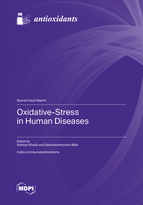Oxidative-Stress in Human Diseases
A special issue of Antioxidants (ISSN 2076-3921). This special issue belongs to the section "Health Outcomes of Antioxidants and Oxidative Stress".
Deadline for manuscript submissions: closed (15 July 2022) | Viewed by 51523
Special Issue Editors
2. Faculty of Sciences, Tel Hai Academic College, Qiryat Shemona 12208, Israel
Interests: natural compounds; analytical chemistry; metabolomics; oxidative stress; atherosclerosis
Special Issues, Collections and Topics in MDPI journals
Special Issue Information
Dear Colleagues,
Oxidative stress (OS) plays an essential role in the pathogenesis of human chronic diseases such as cardiovascular and kidney diseases, diabetes, neurodegenerative disorders, cancer, inflammation-related diseases, and aging. OS is a condition characterized by an imbalance between production and accumulation of oxygen and nitrogen reactive species (ROS/RNS) in cells and tissues and it occurs when the generation of these compounds exceed the ability of the biological system to neutralize them.
ROS/RNS, such as superoxide (O2•−), hydrogen peroxide (H2O2), hydroxyl radical (HO•), nitrogen oxide (NO•), peroxynitrite (ONOO−) and hypochlorous acid (HOCl), are all products of normal metabolic pathways in humans and their production may be increased as a result of the influence of external factors, such as pollution, cigarette smoke, or internally, as a result of impaired intracellular metabolism. Long term exposure to increased levels of ROS/RNS can cause structural defects of lipids, proteins, DNA and RNA, as well as functional alteration of several enzymes and cellular structures leading to an increase of OS and pathogenesis.
We invite you to share with our community your latest original and innovative research findings or review articles in the upcoming Special Issue “Oxidative-Stress in Human Diseases”. We welcome clinical and pre-clinical studies of the relationship between OS and human diseases, novel diagnosis methods and mechanisms, as well as approaches for the prevention and treatment of diseases related to OS.
Prof. Dr. Soliman Khatib
Dr. Dana Atrahimovich Blatt
Guest Editors
Manuscript Submission Information
Manuscripts should be submitted online at www.mdpi.com by registering and logging in to this website. Once you are registered, click here to go to the submission form. Manuscripts can be submitted until the deadline. All submissions that pass pre-check are peer-reviewed. Accepted papers will be published continuously in the journal (as soon as accepted) and will be listed together on the special issue website. Research articles, review articles as well as short communications are invited. For planned papers, a title and short abstract (about 100 words) can be sent to the Editorial Office for announcement on this website.
Submitted manuscripts should not have been published previously, nor be under consideration for publication elsewhere (except conference proceedings papers). All manuscripts are thoroughly refereed through a single-blind peer-review process. A guide for authors and other relevant information for submission of manuscripts is available on the Instructions for Authors page. Antioxidants is an international peer-reviewed open access monthly journal published by MDPI.
Please visit the Instructions for Authors page before submitting a manuscript. The Article Processing Charge (APC) for publication in this open access journal is 2900 CHF (Swiss Francs). Submitted papers should be well formatted and use good English. Authors may use MDPI's English editing service prior to publication or during author revisions.
Keywords
- Oxidative Stress
- ROS/RNS
- Human Diseases
- Antioxidants
- OS Biomarkers








